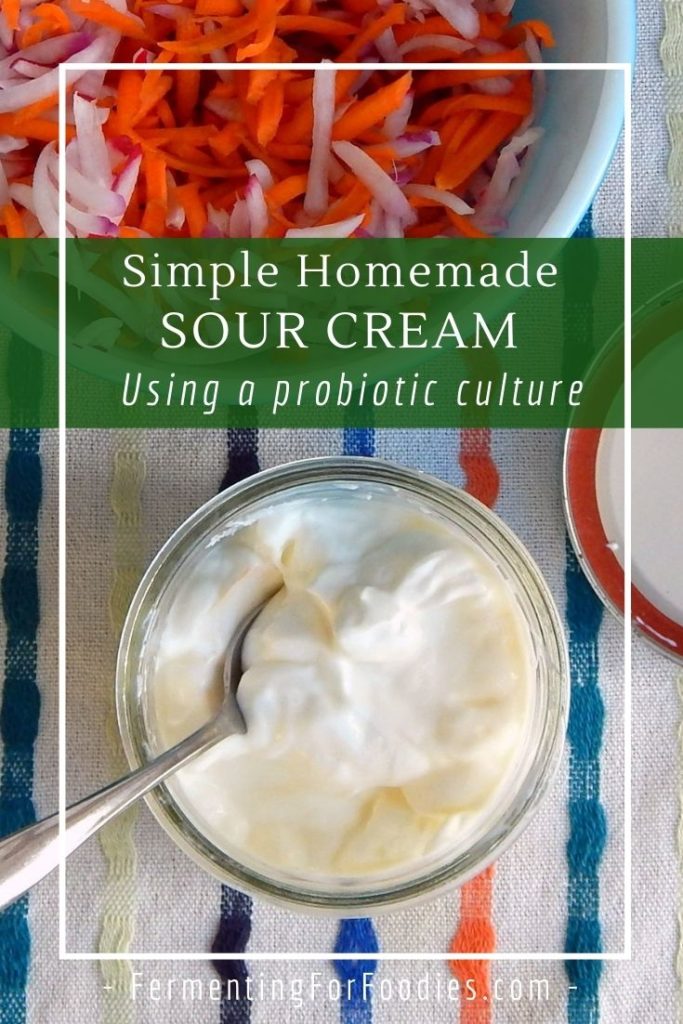
It’s so quick and easy to make homemade sour cream. This traditional recipe uses a probiotic culture, so it can be as sour as you want. It’s perfect for tacos, pierogies, soups and dips.
Here are some of the reasons why you should make your own sour cream:
- It’s probiotic!
- You get to decide how sour you want it.
- The flavour of cultured dairy is delicious.
- The price of the cream is less than the price of sour cream, so it’s a cheap alternative.
- Homemade sour cream is zero-waste (or lower waste). No need to recycle a plastic container.
- It’s easy! Just mix in the culture and you’re done.
Sour Cream Culture
A good mesophilic (room temperature loving) culture is traditional for sour cream. This type of culture works best at 22C (72F), so there’s no need to heat the cream or keep it warm in a yogurt maker.
The flavour of the sour cream will be affected by your choice of culture, so if you want a traditional sour cream flavour, then you will need a traditional sour cream culture. Here are some different mesophilic cultures that will work for sour cream:
- You can buy sour cream culture online (affiliate link). It will be very vigorous and is a great way to kickstart your own homemade sour cream culture.
- Sometimes store-bought sour cream is cultured. However, not all of them are, so you will need to read the label. Store-bought sour cream is generally not a very vigorous culture, so give it a full 24 hours the first time you use it to make homemade sour cream.
- Cultured buttermilk is a great alternative as the flavour is similar to sour cream.
- Milk kefir can culture cream, but the yeast part of the culture will change the flavour and consistency of the sour cream to be more like milk kefir.
- Mesophilic yogurts also have their own, unique flavour. So, they can culture whipping cream, but it won’t taste like store-bought sour cream.
Maintaining A Sour Cream Culture
Like all fermented cultures, sour cream needs to be fed regularly to remain healthy and vigorous. Realistically, that means making sour cream once a week! However, dairy cultures freeze very well. Here’s how to freeze sour cream culture for future batches:
- Whenever you make sour cream, freeze enough culture for the next batch. It will last in the freezer for at least 4 weeks (and up to several months).
- Defrost the frozen culture for 24 hours in the fridge before using it.
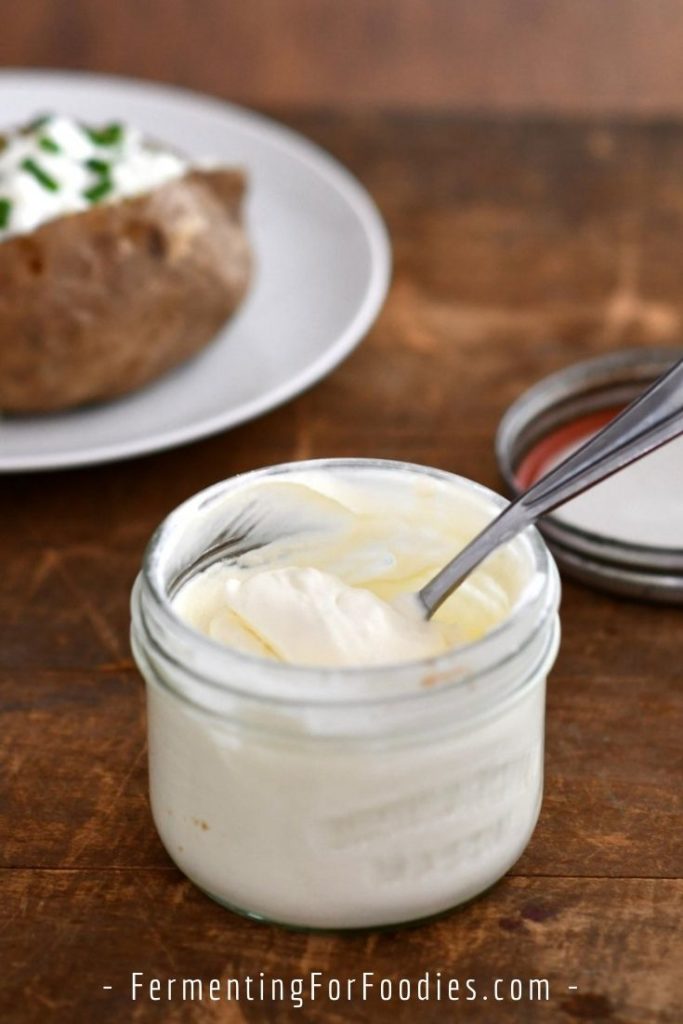
Traditional Homemade Sour cream
Traditional sour cream is made with a bacterial culture that sets at room temperature. It is probiotic and delicious. Perfect for tacos, pierogies and more!
- Prep Time: 5 minutes
- Total Time: 5 minutes
- Yield: 1 1/4 cup 1x
- Category: Condiment
- Method: Fermented
- Cuisine: Probiotic
- Diet: Vegetarian
Ingredients
- 1/4 cup of mesophilic cultured dairy (see the section above for different culturing options)
- 1 cup whipping cream (30-35% milkfat)
Instructions
- Mix the culture and cream in a clean glass jar.
- Loosely screw on the lid and leave it at room temperature (around 22 C, 72 F) for 12-24 hours.
- Once it has thickened and tastes sour, store it in the fridge and finish it within 3 weeks.
Notes
- You can find mesophilic dairy cultures in most grocery stores (eg. buttermilk). See the section above for more detailed information.
- The first time you make sour cream it may take a little longer to achieve a sour flavour. It will depend on the quality of your culture. However, once you’ve established your culture, it should be relatively quick.
- The cream will thicken as it cultures, but if you want a really thick sour cream, then strain it through a coffee filter (like Greek yogurt). Store-bought sour cream contains a bunch of added ingredients to help thicken the cream, so don’t expect your homemade sour cream to be as thick.

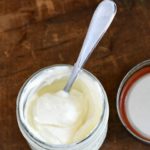
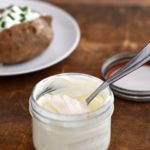
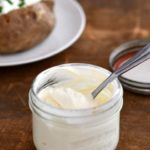

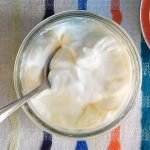
I use 2 Table Spoons of liquid from homemade sauerkraut as my starter.
Interesting… I’ve never tried culturing dairy with sauerkraut. What a good idea!
Hi Matt.
I’ve just made my first batch of sauerkraut. Now I’d like to make sour cream. Do you add 2 Tablespoons of liquid to 1 cup of heavy cream? Thanks!
Hi Sherry, I never tried Matt’s method. (I keep sour cream starter in my freezer). However, if you try it can you let me know how it goes? Thanks!
Interesting! Another use for the Juice! I do kimchi sort of, cuise before to change the mouth feel. What a paradigm shift! TX!
I’m trying to help my family get healthier microbiomes by using more homemade, cultured, products. Thank you for posting such recipes – I’ll be trying them out and teaching them to my daughter.
So many milk products in the store are “ultra-pasteurized” and don’t even taste good to my way of thinking. Do these products work for cultures?
Sorry, ultra-pasteurized generally don’t work for fermentation. If you can’t find regular milk, then you could try them. But I would recommend avoiding them.
I decided to give your method a try and it worked beautifully even though I used ultra pasteurized whipping cream along with some of the sour cream I had on hand. I mixed it in a quart jar with a plastic lid and put it in the oven with the oven light on overnight and brought it out this morning. It was not totally thickened but it smelled good. So I stirred it slightly and set it on top of the stove. This evening it is beautiful sour cream, totally delicious, thickened to the right consistency. I cut up some fresh fruit, put a dollop of this wonderful sour cream next to the fruit and piled on a little bit of brown sugar. What a treat! Thank you for simplifying this process. I will never have to buy sour cream again.
Thanks for sharing. I’ve never tested this recipe with ultra-pasteurized whipping cream. So glad to hear that it worked!
Thank you for letting me know about the ultra pasteurized milk .I love making homemade food and I agree ultra pasteurized doesnt cut it in my taste.Yrars ago I actually had an uncle who had a nueben goat and he gave me a glass of the milk..Yummo
Can you please clarify re-culture? I used a store bought packet of sour cream culture. It made a great sour cream, how do I feed the current sour cream to keep it going? If I add kefir it will change the flavor and i really want to preserve the flavor that I have. Thank for your help!
Hi, Definitely don’t mix it with kefir. You’ll end up with kefir cultured cream, which I often make instead of sour cream, but it is a different culture. To keep your store-bought culture active, simply save 1/4 cup of your cultured sour cream to reculture the next batch. I would culture it away from your milk kefir, like only have one of them out of the fridge at a time, or culture them in different rooms. Otherwise, the milk kefir will slowly take over your sour cream culture. Enjoy!
I have been using ultra pasteurized half and half to make yogurt in my instant pot using the cold start method. That can only be done using ultra pasteurized. It comes out perfect and taste wonderful. Can you make sour cream from taking the whey out of yogurt?
Not exactly. Removing the whey will turn it into Greek yogurt. It will be thicker, but not creamy like sour cream. However, it’s a great option for a low-fat “sour cream”. Depending on what you’re using it for, you may not even notice the difference.
Do you have any experience with what happens if you greatly extend the culturing time of this, possibly for more than 48 hours? I’ve been culturing my own cream at home with some milk kefir grains and I tried an extended ferment. After I stopped the ferment and put it in the fridge, checking on it later showed that it was solid! I’ve taken a bit more out to see if this will basically yield butter if I extend the process further, but if you have any experience I’d love your insight!
Thanks!
Hi, Fermenting for longer does result in the cream curding. So the whey may separate from the solids. It’s not exactly butter, however, you’re on your way! To make butter, remove the kefir grains and start shaking! I have a recipe for cultured butter here: https://www.fermentingforfoodies.com/homemade-cultured-butter/
I made some sour cream with local raw cream and have some extra cream that went sour after 2-3 weeks in the fridge. Can I use this when I re-culture? If not, do you have any recommendations for it?
If you had raw cream that went sour on its own, then I wouldn’t use it to reculture more sour cream. You don’t know exactly which strains of bacteria cultured the raw milk. You can use store-bought cultured buttermilk, store-bought cultured sour cream or milk kefir to make sour cream. These will each have their own specific bacterial cultures and should make safe and delicious sour cream.
Can the whey be used for the starter? Worx with kraut
Yup!
I’d like to try your recipe, but I’ve learned the hard way that using “fine-filtered” milk and UHT pasteurized creams (all cream and all milk except for Quebon milk here in Quebec) means I cannot make ricotta, paneer, and farmer’s cheeses.
The milk industry in Canada is very rich, and no wonder—the cheapest milk costs $8.00 a gallon—which is the same price as a pound of butter—with recent price increases. I assume it would be the same with your recipe, and I would need to find cream that is not UHT pasteurized—which I haven’t been able to do so, yet, but a guy can dream, right?
I’m in BC, so the milk situation is a bit different. Not being able to find milk that is not UHT or fine-filtered sounds very frustrating. Where I live, we have 2 small producers that provide non-homogenized milk, which is perfect for cheesemaking. Are there any small producers near you? Or is the processing due to provincial regulations? Be well, Emillie
Well, I think pasteurization (government regs.) is fine, but I don’t like that they use UHT pasteurization for cream. I’m a monk and I live on a small budget, so I can buy cream that is non-pasteurized, but it costs 9.00 for like 2 cups, meaning I can’t buy it all the time as I wish. In Boston where I’m from or in the US a gallon of milk was 3.00 a gallon, unlike the 9.00 a gallon here. it must be the same in BC. I wrote the reply because I was wondering if those who had not succeeded in making the sour cream had failed because they. Ishtar also have been using UHT cream and milk. In any case. I will try recipe soon. Be well.
Interesting! It never occurred to me that cream would be UHT! My dairy situation is more similar to what you found in Boston than in Quebec. I wonder why? Anyway, I wish you luck in your search for dairy. Emillie
If I want to double the recipe and I’m using leftover sour cream, do I need to double the amount to ½ cup or will it still be ¼ cup?
If I’m using culture from a previous batch but want to double my recipe will I still use ¼ cup of culture or do I need ½ cup?
The amount of culture will influence how long it takes to ferment. So, if you use 1/4 cup then just expect it to take a bit longer. Cheers!
I will NEVER buy sour cream again! I used a high quality cultured buttermilk to start, and ultra-pasteurized heavy cream because I couldn’t find any non-ultra anywhere. It reached just the right “tang” in 45 hours and I’ve saved some in the freezer for my next batch. My husband is a little picky about homemade things like this, but he loves it as do I. We are building in the country and I already know of farmers around us from whom we can buy high-quality meat and dairy and I’m excited to do all these things with more natural products. THANK YOU for sharing this!
So glad it hear that ultra pasteurized cream worked! I’ve never tried it before. And I’m so glad you enjoy your DIY sour cream. 🙂 Thanks for sharing! Cheers, Emillie
Can you use thermophilic cultures (like from yoghurt) to make sour cream? By simply adding it to the cream and heating it up to around 42’C degrees?
Yes! You can definitely use yogurt to culture cream. Enjoy!